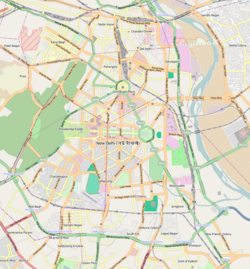| Afsarwala tomb | |
|---|---|
 Afsarwala tomb in 2018 Afsarwala tomb in 2018 | |
| Religion | |
| Affiliation | Islam |
| Ecclesiastical or organisational status | Mausoleum and mosque |
| Status | Active |
| Location | |
| Location | Humayun's Tomb, East Nizamuddin, Delhi |
| Country | India |
 | |
| Geographic coordinates | 28°35′33″N 77°14′53″E / 28.59250°N 77.24806°E / 28.59250; 77.24806 |
| Architecture | |
| Type | Mosque architecture |
| Style | |
| Completed | AH 974 (1566/1567 CE) |
| Specifications | |
| Dome(s) | One |
| Materials | Red sandstone |
| UNESCO World Heritage Site | |
| Type | Cultural |
| Criteria | (ii), (iv) |
| Designated | 1993 (17th session) |
| Part of | Humayun's Tomb |
| Region | India |
| Monument of National Importance | |
| Official name | Afsah-walla-ki-Masjid |
| Part of | Humayun's Tomb |
| Reference no. | N-DL-120 |
The Afsarwala tomb complex consists of a tomb and mosque, located inside the Humayun's Tomb, in East Nizamuddin, Delhi, India. The mausoleum houses the tomb of an unknown person.
The tomb, together with other structures, forms the UNESCO World Heritage Site of Humayun's tomb complex. The mosque is also a Monument of National Importance.
Location
The Afsarwala tomb is located east of the Arab Serai at the Humayun's Tomb complex in Delhi, India. The Afsarwala tomb is located south-east from the mosque.
Name and dating
According to an explanation by the Archeological Survey of India the name "Afsarwala tomb" could derive from the Persian word afsar (افسر), which itself derives from the English word officer, making the building an "officer-wala's tomb", a grave for a military commander. A more recent theory points to the Persian tribal name Afsar, noting that several Afsars were employed at the early Mughal court, including one namebearer, who helped Humayun during his return and recapture of India in 1555.
One of the graves inside the mausoleum contains the number 974, believed by the Archaeological Survey of India to indicate that the mausoleum may have been built in AH 974 (1566/1567 CE).
Architecture
Mosque
According to archaeological evidence, the mosque was built between 1560 and 1567. Located adjacent to the Afsarwala tomb, the mosque is built on the same raised platform as the tomb. The façade contains three arches, with red-painted spandrels, each arch enclosing its own alcove. Staircases to the terrace are located at the extreme two sides of the mosque.
Stucco lines the mosque's interior, with ceiling arches containing medallions. The soffit of the nave is painted stucco. The drum which sits underneath the dome of the mosque is octagonal on the outside, but square in shape internally. Red paint is used to decorate the drum.
There is only one dome and chhatri. Ram Nath opines that the plan of the mosque is nothing new and the themes are just replicas of previous mosques.
Tomb
The Afsarwala tomb is built on the raised platform of the mosque. The mausoleum is built from grey quartz and lined with red sandstone and marble. A single cruciform chamber with a double dome is located inside the mausoleum. Externally, the mausoleum is octagonal in shape. Each side of the octagon contains an arch with a squared doorway, which opens into the inner chamber. Red sandstone is used to decorate the spandrels of the arches. The external dome rises from an octagonal drum and is crowned by a red sandstone lotus finial.
Gallery
-
 The plaque outside the complex
The plaque outside the complex
-
 Afsarwala mosque
Afsarwala mosque
-
 Mihrab of the mosque
Mihrab of the mosque
-
 Afsarwala masouleum
Afsarwala masouleum
-
 Calligraphic inscription inside the mausoleum
Calligraphic inscription inside the mausoleum
-
 The grave chamber containing the cenotaphs
The grave chamber containing the cenotaphs
-
 An 1803 painting of the complex
An 1803 painting of the complex
See also
Notes
- ASI description: Afsah-walla-ki-Masjid: Situated outside the west gate of Humayun's tomb with its dalans and paved court bounded on the east by Humayun's tomb on the west by Abadi Arab Sarai on the north by road and Khasra No. 252 and on the south by Abadi Arab Sarai.
References
- ^ "List of Ancient Monuments and Archaeological Sites and Remains of Delhi". Archaeological Survey of India. Retrieved 2 October 2018.
- "Sahih al-Bukhari 437" كتاب الصلاة [Prayers (Salat)]. sunnah.com صلى الله عليه و سلم [Sayings and Teachings of Prophet Muhammad] (in Arabic). Retrieved 12 March 2021.
- Sharma 1974, p. 110.
- Sharma 1974, p. 110–111.
- Parihar, Subhash (1998). The Afsarwali Masjid and Afsarwala Gumbad at Nizamuddin, Delhi. Vol. 49. Marg. pp. 78–83.
- Sharma 1974, p. 111.
- Naqvi 2002, p. 64.
- ^ Nath 1982, p. 234.
- Heras Institute of Indian History and Culture, St. Xavier's College (1979). Indica. Vol. 16. p. 205.
- "Afsarwala Mosque". ArchNet.
- Naqvi 2002, p. 65.
- Naqvi 2002, p. 66.
Bibliography
- Naqvi, S. A. A. (2002), Humayun's Tomb and other Adjacent Monuments, Archaeological Survey of India, ISBN 9788187780083
- Nath, Ram (1982), History Of Mughal Architecture Vol.1, Abhinav Publications, ISBN 9788170171591
- Sharma, Y. D. (1974), Delhi and its neighbourhood, Archaeological Survey of India
External links
- UNESCO website
| Humayun's tomb | |
|---|---|
|
- 16th-century mosques in India
- Indo-Islamic architecture
- Mausoleums in Delhi
- Monuments of National Importance in Delhi
- Mosque buildings with domes in India
- Mosques completed in the 1560s
- Mosques in Delhi
- Mughal mosques
- Sandstone buildings in India
- Tourist attractions in Delhi
- World Heritage Sites in India
- Religious buildings and structures completed in 1567
- Tombs in Delhi